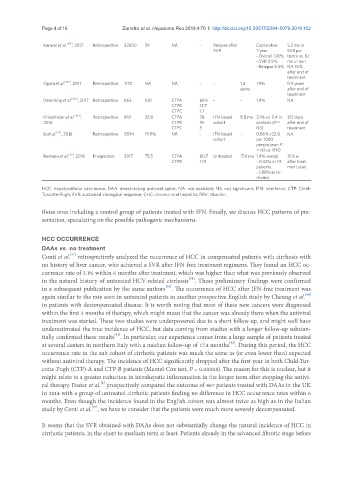Page 784 - Read Online
P. 784
Page 4 of 16 Zanetto et al. Hepatoma Res 2018;4:70 I http://dx.doi.org/10.20517/2394-5079.2018.102
Kanwal et al. [101] , 2017 Retrospective 22500 39 NA - Relapse after Cumulative 5.2 mo in
SVR 1-year SVR pa-
- Overall 1.18% tients vs. 6.1
- SVR 0.9% mo in non
- Relapse 3.4% NA SVR,
after end of
treatment
Ogata et al. [102] , 2017 Retrospective 1170 NA NA - - 1.3 1.9% 0.5 years
years after end of
treatment
Deterding et al. [103] , 2017 Retrospective 863 100 CTPA 69.9 - - 1.4% NA
CTPB 13.7
CTPC 1.7
Finkelmeier et al. [104] , Retrospective 819 32.8 CTPA 78 IFN-based 8.8 mo 3.1% vs. 5.4 in 312 days
2018 CTPB 19 cohort controls (P = after end of
CTPC 3 NS) treatment
Li et al. [53] , 2018 Retrospective 5834 19.9% NA - IFN-based - 0.86% (22.8 NA
cohort per 1000
person year; P
= NS vs. IFN)
Romano et al. [42] , 2018 Prospective 3917 75.5 CTPA 80.7 Untreated 17.4 mo 1.4% overall 31.8 w
CTPB 11.9 - 0.42% in F3 after treat-
patients ment start
- 1.88% in cir-
rhotics
HCC: hepatocellular carcinoma; DAA: direct-acting antiviral agent; NA: not available; NS: not significant; IFN: interferon; CTP: Child-
Turcotte-Pugh; SVR: sustained virological response; CHC: chronic viral hepatitis; RBV: ribavirin
those ones including a control group of patients treated with IFN. Finally, we discuss HCC patterns of pre-
sentation, speculating on the possible pathogenic mechanisms.
HCC OCCURRENCE
DAAs vs. no treatment
[37]
Conti et al. retrospectively analyzed the occurrence of HCC in compensated patients with cirrhosis with
no history of liver cancer, who achieved a SVR after IFN-free treatment regimens. They found an HCC oc-
currence rate of 3.1% within 6 months after treatment, which was higher than what was previously observed
[38]
in the natural history of untreated HCV-related cirrhosis . These preliminary findings were confirmed
in a subsequent publication by the same authors . The occurrence of HCC after IFN-free treatment was
[39]
[40]
again similar to the rate seen in untreated patients in another prospective English study by Cheung et al.
in patients with decompensated disease. It is worth noting that most of these new cancers were diagnosed
within the first 3 months of therapy, which might mean that the cancer was already there when the antiviral
treatment was started. These two studies were underpowered due to a short follow-up, and might well have
underestimated the true incidence of HCC, but data coming from studies with a longer follow-up substan-
tially confirmed these results . In particular, our experience comes from a large sample of patients treated
[41]
[42]
at several centers in northern Italy with a median follow-up of 17.4 months . During this period, the HCC
occurrence rate in the sub cohort of cirrhotic patients was much the same as (or even lower than) expected
without antiviral therapy. The incidence of HCC significantly dropped after the first year in both Child-Tur-
cotte-Pugh (CTP)-A and CTP-B patients (Mantel-Cox test, P = 0.00008). The reason for this is unclear, but it
might relate to a greater reduction in intrahepatic inflammation in the longer term after stopping the antivi-
ral therapy. Foster et al. prospectively compared the outcome of 467 patients treated with DAAs in the UK
[2]
in 2014 with a group of untreated cirrhotic patients finding no difference in HCC occurrence rates within 6
months. Even though the incidence found in the English cohort was almost twice as high as in the Italian
[37]
study by Conti et al. , we have to consider that the patients were much more severely decompensated.
It seems that the SVR obtained with DAAs does not substantially change the natural incidence of HCC in
cirrhotic patients, in the short to medium term at least. Patients already in the advanced fibrotic stage before

